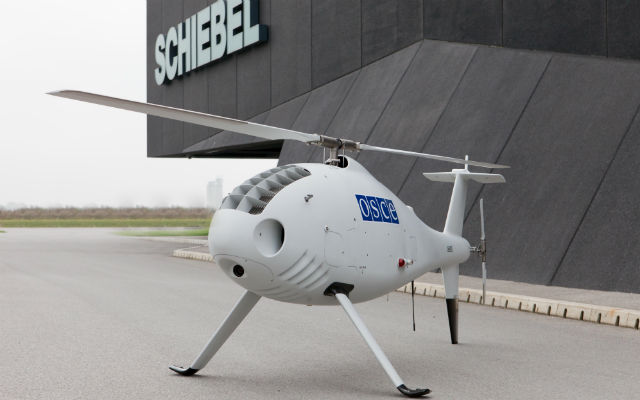The Organization for Security and Cooperation in Europe (OSCE) has announced that its recently deployed Schiebel Camcopter unmanned air vehicle was the target of anti-aircraft gunfire above Ukraine, although it managed to fly away undamaged.
The UAV has been deployed in a surveillance capacity under the OSCE’s Special Monitoring Mission (SMM) to Ukraine for the past couple of weeks, although operations have not been straightforward as it has been the target of both gunfire and GPS jamming.
On 2 November, the rotary-wing UAV was fired at by a vehicle-mounted anti-aircraft gun, which OSCE says was likely a Russian-made ZU-23 – at a location 2.5km north east of Shyrokyne in Ukraine and 17km east of Mariupol.
The latter is a territory that falls under control of the self-proclaimed Donetsk People’s Republic, which is publicly denounced by the Ukrainian government and the West and is is likely to be a high-alert area for the OSCE’s Ukrainian mission.
The Camcopter was flying at about 5,000ft when it observed an armoured personnel carrier and two Ural trucks at a checkpoint. A camouflaged man standing next to a civilian truck by the military vehicles then aimed a man-portable air-defence system – a weapon that has been prevalent in the region throughout the conflict – at the Camcopter before deciding to store it on the vehicle and aim the gun at the UAV instead.
No gun rounds hit the UAV, and it landed about 45 minutes after leaving the area, OSCE says. Post-flight analysis of the video footage was completed later that day.
During the flight, the “unique identifier” of the UAV's transponder – call-sign UAV 308 – was visible to airspace management radars, OSCE adds.

Schiebel
On 3 November, the SMM tweeted that the Camcopter had been subject to GPS jamming on 29 October about 3km west of Sartana, but the OSCE emphasised that on this occasion it also left safely.
Schiebel is providing 12-hour coverage to the OSCE over Ukraine but will ramp this up to 24-hour surveillance once a second Camcopter system is delivered, Schiebel told Flightglobal on 28 October.
The company is being contracted on a month-by-month basis for the services over the disputed areas; a contract for the UAV support was awarded not long after Malaysia Airlines flight MH-17 was brought down over Donetsk on 17 July by what is believed to have been a surface-to-air weapon.
Meanwhile, the OSCE is also considering deploying further types of UAVs over the conflict zone, saying on 17 October that it would consult on a number of European types that had been offered for the mission.
Didier Burkhalter, Swiss foreign minister and OSCE chairperson-in-office, thanked those who offered systems – offers came from Italy, France, Germany, Ukraine and Russia – to “put at the OSCE’s disposal UAVs and related personnel to enhance its monitoring capacities in Ukraine”.
Burkhalter announced that “immediate consultations by the chairmanship on the modalities concerning the use of these additional OSCE monitoring resources” would take place.
“Burkhalter called on all sides to show good will and pragmatism to enable the OSCE to effectively integrate these UAVs in its monitoring activities as fast as possible,” the organisation adds.
Source: FlightGlobal.com






















